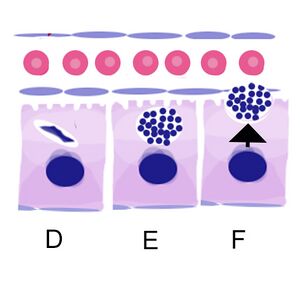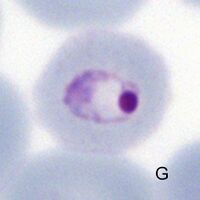Pre-erythrocytic (liver) stage: Difference between revisions
From haematologyetc.co.uk
No edit summary |
No edit summary |
||
| Line 17: | Line 17: | ||
</gallery> | </gallery> | ||
The initial mosquito bite (Image A): blood from the host is taken through as mosquito mouthparts (m) | The initial mosquito bite (Image A): blood from the host is taken through as mosquito mouthparts (m) from small vessels (v). At the same time fluid from mosquito salivary glands passes into the vessel. If a mosquitos is host to the malaria organism then parasites enter the blood (in the form of '''"sporozoites"''' (sp)). | ||
---- | ---- | ||
| Line 28: | Line 28: | ||
File:Liver 1.jpg|<span style="font-size:80%">''Formation and release of merozoites''</span>|link={{filepath:Liver 1.jpg}} | File:Liver 1.jpg|<span style="font-size:80%">''Formation and release of merozoites''</span>|link={{filepath:Liver 1.jpg}} | ||
</gallery> | </gallery> | ||
The sporozoites that have entered the blood then pass through the blood vessel and into the cells of the liver (B). They may pass through multiple cells but then remain in a single liver cell (C). | |||
---- | ---- | ||
Revision as of 10:44, 22 April 2024
Navigation
(click blue highlighted text to return to page)
Malaria main index
>Basic malaria biology
>>This page: Pre-erythrocytic (liver) stage
| The schizont pathway |
The initial mosquito bite (Image A): blood from the host is taken through as mosquito mouthparts (m) from small vessels (v). At the same time fluid from mosquito salivary glands passes into the vessel. If a mosquitos is host to the malaria organism then parasites enter the blood (in the form of "sporozoites" (sp)).
| Initial mosquito infection |
The sporozoites that have entered the blood then pass through the blood vessel and into the cells of the liver (B). They may pass through multiple cells but then remain in a single liver cell (C).
| Morphological features and relevance |
| Relevance of schizonts to clinical biology |



